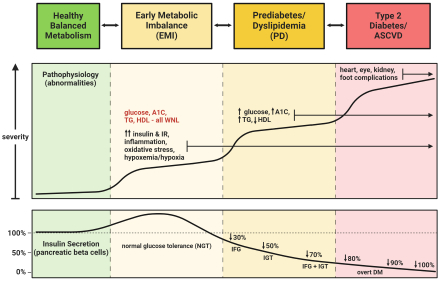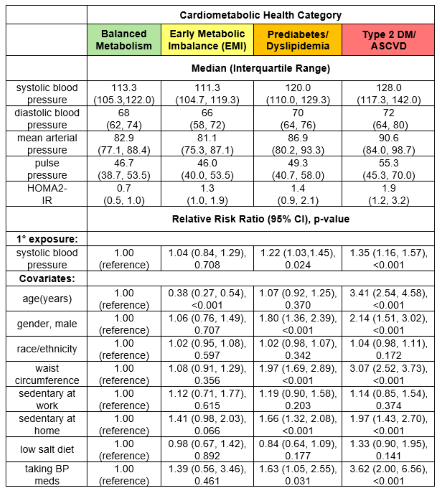Final ID: P3016
Blood Pressure Measures are Not Associated with Early Metabolic Imbalance: The U.S. National Health and Nutrition Examination Survey
Abstract Body:
Introduction: Early metabolic imbalance (EMI) is a hidden condition prevalent in teens and young adults. It is characterized by compensated insulin resistance, where fasting glucose, triglycerides, HDL cholesterol, and hemoglobin A1c are all within normal limits (Fig. 1). Thus, EMI does not meet the criteria for prediabetes or metabolic syndrome and eludes risk screening for type 2 diabetes and CVD. In addition to hyperinsulinemia, EMI is associated with chronic inflammation, oxidative stress, and hypoxia. The overproduction of nitric oxide from high circulating insulin may keep blood pressure low. Therefore, we investigated the association of blood pressure with EMI.
Hypothesis: In EMI, blood pressure measures are lower or unchanged compared to healthy balanced metabolism.
Methods: The fasting subsample from the 2015-2018 U.S. National Health & Nutrition Examination Survey was analyzed: 6,227 observations representing 270.2 million people in the U.S. ages 12 and up. Population-weighted multinomial logistic regression was performed using Stata v18.5. The outcome variable was cardiometabolic health, categorized into 1 of 4 groups: healthy balanced metabolism, EMI, prediabetes/dyslipidemia (PD), or type 2 diabetes/ASCVD (Fig. 1). EMI was defined as elevated fasting insulin with normal glucose, A1c, TG and HDL, using prognostic insulin cutpoints from timeROC analysis of the CARDIA cohort. The 1° exposure was systolic BP. Diastolic BP, mean arterial pressure, and pulse pressure were 2° exposures. The adjusted covariates were age, male gender, race/ethnicity, waist circumference, sedentary behavior, low-salt diet, and BP medications. For measuring association, the effect size was relative risk ratio with 95% confidence interval and p-value.
Results: After adjusting for confounders, no significant change in systolic blood pressure was observed between the EMI and balanced metabolism groups (Table 1). By contrast, the PD and diabetes/ASCVD groups were associated with increases in systolic BP. Nearly identical results were obtained when diastolic BP, mean arterial pressure, or pulse pressure was substituted for systolic BP. Age emerged as the most influential confounder for the association between blood pressure and EMI.
Conclusion: In EMI, blood pressure measures were unchanged compared with healthy balanced metabolism. Higher blood pressure values or taking BP medications may serve as a marker to help differentiate other cardiometabolic health categories from EMI.
Introduction: Early metabolic imbalance (EMI) is a hidden condition prevalent in teens and young adults. It is characterized by compensated insulin resistance, where fasting glucose, triglycerides, HDL cholesterol, and hemoglobin A1c are all within normal limits (Fig. 1). Thus, EMI does not meet the criteria for prediabetes or metabolic syndrome and eludes risk screening for type 2 diabetes and CVD. In addition to hyperinsulinemia, EMI is associated with chronic inflammation, oxidative stress, and hypoxia. The overproduction of nitric oxide from high circulating insulin may keep blood pressure low. Therefore, we investigated the association of blood pressure with EMI.
Hypothesis: In EMI, blood pressure measures are lower or unchanged compared to healthy balanced metabolism.
Methods: The fasting subsample from the 2015-2018 U.S. National Health & Nutrition Examination Survey was analyzed: 6,227 observations representing 270.2 million people in the U.S. ages 12 and up. Population-weighted multinomial logistic regression was performed using Stata v18.5. The outcome variable was cardiometabolic health, categorized into 1 of 4 groups: healthy balanced metabolism, EMI, prediabetes/dyslipidemia (PD), or type 2 diabetes/ASCVD (Fig. 1). EMI was defined as elevated fasting insulin with normal glucose, A1c, TG and HDL, using prognostic insulin cutpoints from timeROC analysis of the CARDIA cohort. The 1° exposure was systolic BP. Diastolic BP, mean arterial pressure, and pulse pressure were 2° exposures. The adjusted covariates were age, male gender, race/ethnicity, waist circumference, sedentary behavior, low-salt diet, and BP medications. For measuring association, the effect size was relative risk ratio with 95% confidence interval and p-value.
Results: After adjusting for confounders, no significant change in systolic blood pressure was observed between the EMI and balanced metabolism groups (Table 1). By contrast, the PD and diabetes/ASCVD groups were associated with increases in systolic BP. Nearly identical results were obtained when diastolic BP, mean arterial pressure, or pulse pressure was substituted for systolic BP. Age emerged as the most influential confounder for the association between blood pressure and EMI.
Conclusion: In EMI, blood pressure measures were unchanged compared with healthy balanced metabolism. Higher blood pressure values or taking BP medications may serve as a marker to help differentiate other cardiometabolic health categories from EMI.
More abstracts on this topic:
Association of Triglyceride Glucose-Related Parameters with All-cause mortality and Cardiovascular Disease in Non-alcoholic Fatty Liver Disease Patients
Chen Yaqin, Zhang Yusha, Wang Fengjiao
A Multimodal Artificial Intelligence Signature of Advanced Cardiac and Vascular Aging Defines Elevated Risk of Cardiovascular DiseasePerera Sudheesha, Biswas Dhruva, Dhingra Lovedeep, Aminorroaya Arya, Coppi Andreas, Khera Rohan


